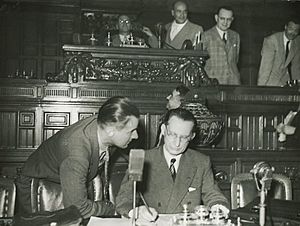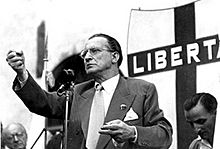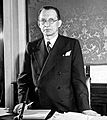Alcide De Gasperi facts for kids
Quick facts for kids
Alcide De Gasperi
|
|||||||||||||||||||||||||||||||||||||||||||
|---|---|---|---|---|---|---|---|---|---|---|---|---|---|---|---|---|---|---|---|---|---|---|---|---|---|---|---|---|---|---|---|---|---|---|---|---|---|---|---|---|---|---|---|
 |
|||||||||||||||||||||||||||||||||||||||||||
| Prime Minister of Italy | |||||||||||||||||||||||||||||||||||||||||||
| In office 10 December 1945 – 17 August 1953 |
|||||||||||||||||||||||||||||||||||||||||||
| President | |||||||||||||||||||||||||||||||||||||||||||
| Monarch | |||||||||||||||||||||||||||||||||||||||||||
| Lieutenant General | Prince Umberto | ||||||||||||||||||||||||||||||||||||||||||
| Deputy |
|
||||||||||||||||||||||||||||||||||||||||||
| Preceded by | Ferruccio Parri | ||||||||||||||||||||||||||||||||||||||||||
| Succeeded by | Giuseppe Pella | ||||||||||||||||||||||||||||||||||||||||||
| President of the Common Assembly | |||||||||||||||||||||||||||||||||||||||||||
| In office 11 May 1954 – 19 August 1954 |
|||||||||||||||||||||||||||||||||||||||||||
| Preceded by | Paul-Henri Spaak | ||||||||||||||||||||||||||||||||||||||||||
| Succeeded by | Giuseppe Pella | ||||||||||||||||||||||||||||||||||||||||||
|
|||||||||||||||||||||||||||||||||||||||||||
|
|||||||||||||||||||||||||||||||||||||||||||
|
|||||||||||||||||||||||||||||||||||||||||||
| Personal details | |||||||||||||||||||||||||||||||||||||||||||
| Born |
Alcide Amedeo Francesco De Gasperi
3 April 1881 Pieve Tesino, Tyrol, Austria-Hungary |
||||||||||||||||||||||||||||||||||||||||||
| Died | 19 August 1954 (aged 73) Borgo Valsugana, Trentino, Italy |
||||||||||||||||||||||||||||||||||||||||||
| Political party |
|
||||||||||||||||||||||||||||||||||||||||||
| Spouses |
Francesca Romani
(m. 1922) |
||||||||||||||||||||||||||||||||||||||||||
| Children | 4 | ||||||||||||||||||||||||||||||||||||||||||
| Alma mater |
|
||||||||||||||||||||||||||||||||||||||||||
| Profession |
|
||||||||||||||||||||||||||||||||||||||||||
Alcide De Gasperi (born April 3, 1881 – died August 19, 1954) was an important Italian politician. He helped create the Christian Democracy party. He served as the prime minister of Italy for eight governments in a row, from 1945 to 1953.
De Gasperi was the last prime minister of the Kingdom of Italy. He worked under two kings, Victor Emmanuel III and Umberto II. He then became the first prime minister of the Italian Republic. He was also briefly the temporary head of state after Italy voted to become a republic. His eight years in office were a very long time for a leader in modern Italian politics.
He was a strong Catholic and is known as one of the founding fathers of the European Union. He worked with other important figures like Altiero Spinelli to build a united Europe.
Contents
Early Life and Education
Alcide De Gasperi was born in 1881 in Pieve Tesino. This area, called Tyrol, was then part of Austria-Hungary. Today, it is part of Italy's Trentino-Alto Adige region. His father was a police officer with little money.
From 1896, De Gasperi was active in a movement that mixed social ideas with Christian values. In 1900, he went to the University of Vienna to study literature and philosophy. There, he helped start a Christian student group. He was inspired by a message from Pope Leo XIII called Rerum novarum, which talked about social justice.
In 1904, he took part in student protests. They wanted a university where Italian was spoken. He was arrested and held for 20 days. In 1905, De Gasperi earned his degree in philology, which is the study of language and texts.
Early Career and Politics
In 1905, De Gasperi started working as an editor for a newspaper called La Voce Cattolica. Later, it became Il Trentino, and he became its main editor. In his newspaper, he often wrote about the importance of Italian culture in Trentino. He also supported the region having its own cultural autonomy, meaning self-governance. He was against plans by German nationalists to make Tyrol more German. At that time, he did not seek to join Italy.
In 1911, he became a member of the Austrian Parliament, called the Reichsrat. He represented the Popular Political Union of Trentino (UPPT) for six years. When World War I started, he tried to stay neutral. He supported efforts by Pope Benedict XV and Karl I of Austria to find a peaceful end to the war. Eventually, he sided with Italy.
Struggles Against Fascism
In 1919, De Gasperi helped create the Italian People's Party (PPI) with Luigi Sturzo. He was a member of the Italian Parliament from 1921 to 1924. This was when Fascism started to grow in Italy.
At first, De Gasperi supported the PPI joining Benito Mussolini's government in 1922. But as Mussolini gained more power, De Gasperi disagreed with him. He opposed Mussolini's changes to the government and election rules. He also spoke out against the violence used by Fascists, especially after the murder of Giacomo Matteotti. The PPI party split, and De Gasperi became the leader of the group that opposed Fascism in May 1924. In November 1926, the Fascist government banned the PPI party.
Imprisonment and Vatican Work
De Gasperi was arrested in March 1927 and sent to prison for four years. The Vatican helped him get released early. After a year and a half in prison, his health was very poor.
When he was released in July 1928, he had no job and little money. But in 1929, his contacts in the Church helped him get a job. He worked as a cataloger in the Vatican Library for 14 years. He stayed there until Fascism collapsed in July 1943.
During the 1930s, De Gasperi wrote articles for a Vatican magazine. He wrote about the main political struggle between communism and Christianity.
Founding Christian Democracy
During World War II, De Gasperi secretly helped set up the Christian Democracy (DC) party. This party was based on the ideas of the old PPI. In January 1943, he wrote a plan for the new party called "Ideas for Reconstruction." He became the first leader of the DC party in 1944.
De Gasperi was the clear leader of the Christian Democrats. This party was the most powerful in Italy for many decades. Even though he seemed to have full control, he had to carefully balance different groups within the party. These groups had different ideas about relations with the Vatican, social changes, and foreign policy.
When the southern part of Italy was freed by the Allies, De Gasperi became a key representative of the DC party. He served as a minister without a specific department in one government. In another government, he became the minister of foreign affairs.
Prime Minister of Italy
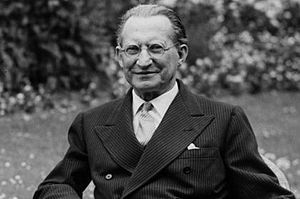
From 1945 to 1953, Alcide De Gasperi was the prime minister of Italy. He led eight different governments, all led by the Christian Democrats. His eight years in power were a very long time for a leader in modern Italian politics.
During his time as prime minister, many important things happened in Italy:
- Italy became a republic in 1946.
- Italy signed a peace treaty with the Allies in 1947.
- Italy joined NATO in 1949, becoming an ally of the United States.
- The United States helped Italy's economy recover through the Marshall Plan.
- Italy became a member of the European Coal and Steel Community (ECSC). This group later grew into the European Union (EU).
In December 1945, De Gasperi became prime minister for the first time. He led a government that included the Italian Communist Party (PCI) and the Italian Socialist Party (PSI), along with other smaller parties. He worked to make the peace treaty with the Allies less harsh for Italy. He also got financial help through the Marshall Plan, which the Communists opposed.
In June 1946, Italians voted in a referendum. They decided whether Italy should remain a monarchy or become a republic. About 54% of voters chose a republic. De Gasperi served as the temporary head of state. Then, the Constituent Assembly elected Enrico De Nicola as the provisional head of state in June 1946.
As the head of the Italian group at the World War II peace conference in Paris, De Gasperi strongly criticized the punishments given to Italy. But he managed to get some agreements from the Allies that protected Italy's independence. Under the peace treaty, Italy lost some eastern land to Yugoslavia. The free territory of Trieste was also divided between the two countries.
One of his big successes in foreign policy was the Gruber-De Gasperi Agreement with Austria in September 1946. This agreement made his home region, South Tyrol, an autonomous region. This meant it could govern itself in many ways.
Support from the United States
De Gasperi had a lot of support from the United States. They saw him as someone who could stop the spread of communism in Italy. The PCI was the largest communist party in a Western European democracy.
In January 1947, De Gasperi visited the US. His main goals were to make the peace treaty with Italy less strict and to get immediate money to help Italy's economy. His ten-day trip was a big success in the media. It led to many positive comments in the American press.
During his meetings in the US, De Gasperi got a US$100 million loan from the Eximbank. This loan was not huge financially, but it was very important politically. De Gasperi believed it showed that the US trusted the Italian government. This helped strengthen his position against the PCI during the start of the Cold War. He also learned that American foreign policy was changing, which led to Italy breaking ties with the PCI and the left-wing PSI. These parties were removed from the government in May 1947.
In May 1947, US President Harry S. Truman asked De Gasperi to form a new government without the communists and socialists. De Gasperi agreed. A new government was formed with centrist parties like the Italian Democratic Socialist Party (PSDI), the Italian Liberal Party (PLI), and the Italian Republican Party (PRI). The leaders of these smaller parties became deputy prime ministers.
The 1948 General Election
The elections in April 1948 were greatly affected by the Cold War. This was a time of tension between the Soviet Union and the United States. After a communist takeover in Czechoslovakia in February 1948, the US worried that Italy might also fall under Soviet influence if the left-wing parties won.
In the United States, a campaign began to stop the Popular Democratic Front (FDP), which was led by communists, from winning. Italian Americans were encouraged to write letters to their relatives in Italy. Famous singer Frank Sinatra even made a radio broadcast. The Central Intelligence Agency (CIA) also secretly gave money to anti-communist candidates. Time magazine supported the campaign and featured De Gasperi on its cover in April 1948.
The election campaign was very intense. It was a fight between two different ideas for Italy's future. One was a Catholic, conservative, and capitalist Italy, supported by De Gasperi's Christian Democrats. The other was a more secular, revolutionary, and socialist society, supported by the Popular Democratic Front. The Christian Democrats' campaign warned that if communists won, bad things would happen. One slogan was, "In the secrecy of the polling booth, God sees you – Stalin doesn't."
The Christian Democrats won a huge victory with 48.5% of the votes. This was their best result ever. They gained strong majorities in both parts of Parliament. The Communists received only half the votes they had in 1946. Even though De Gasperi could have formed a government only with Christian Democrats, he chose a "centrist" group. This group included the Liberals, Republicans, and Social Democrats. He led four more governments over the next five years.
Social Reforms and Changes
De Gasperi's governments made several important social reforms. These changes improved social security in areas like housing, unemployment, and pensions.
In January 1946, the government improved health insurance for farmers and agricultural workers. They received a daily payment and free medical care. In April 1946, health insurance for factory workers was also improved. They got daily payments for sickness and maternity benefits. In October 1947, health insurance for service workers, like those in banking, was also reorganized.
In February 1949, De Gasperi started a seven-year plan for social housing. This plan aimed to build or buy more affordable homes. A special housing fund was also created. In July 1947, a fund was set up to add extra payments to pensions. This helped pensioners deal with rising prices.
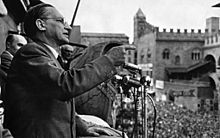
A law in April 1949 brought new rules for unemployment insurance. It set up a commission to check on the job market and help unemployed people. Unemployment payments were increased and lasted longer. Unemployment insurance was also given to agricultural workers. Training programs for the unemployed were also started.

In March 1948, new organizations were created to help orphans of Italian workers and needy pensioners. In August 1950, rules for maternity insurance for all female employees were introduced.
By 1952, the Christian Democracy party strongly supported De Gasperi's leadership. However, this was also the start of his decline. Some members of his party began to criticize him. They said he was too slow with social and economic changes. They also felt he controlled debates too much and put the government's interests before the party's.
The 1953 Election and His Retirement
The 1953 general election had new election rules. The government wanted to give a big bonus of seats in Parliament to any group that won more than two-thirds of the votes. This change was called the Scam Law by those who opposed it. Many opposition parties and even some smaller government parties did not like it.
The Holy See (the Vatican) openly supported the Christian Democracy party. It even said that it would be a mortal sin for a Catholic to vote for the Communist Party. However, many Communists in Italy remained religious.
The campaign against the "Scam Law" worked. The government group won 49.9% of the national vote. This was just a little short of the amount needed for the big seat bonus. So, the seats were divided normally. The Christian Democracy party did not get as many votes as in 1948. They lost votes to right-wing parties, especially in Southern Italy.

Even though the government technically won the election with enough seats, the failure to get the supermajority caused problems. De Gasperi was forced to resign from Parliament on August 2. He then retired from politics. He passed away twelve months later. After him, Italy had several weak governments.
In 1954, De Gasperi also stepped down as the leader of the Christian Democracy party. Amintore Fanfani became the new Secretary in June.
Death and Lasting Impact
Alcide De Gasperi died on August 19, 1954, in Sella di Valsugana, in his beloved Trentino region. It is said that he had very little money when he died, so he was given a State funeral. He is buried in the Basilica di San Lorenzo fuori le Mura, a church in Rome. In 1993, the process began to consider him for beatification, a step towards sainthood in the Catholic Church.
His former secretary, Giulio Andreotti, who also became prime minister, said that De Gasperi "taught us to search for compromise, to mediate."
De Gasperi is seen as one of the founding fathers of the European Union. He often met with other important European leaders like Robert Schuman and Konrad Adenauer. He helped create the Council of Europe. He also supported the Schuman Declaration, which led to the creation of the European Coal and Steel Community in 1951. This was an early step in European integration. In 1954, he was elected president of the Community's Common Assembly, which was a forerunner of the European Parliament. De Gasperi also helped develop the idea of a common European defense policy.
In 1952, he received the Karlspreis. This award from the German city of Aachen honors people who have helped the idea of European unity and peace. The 1954–1955 school year at the College of Europe was named in his honor.
Personal Life
On June 14, 1922, De Gasperi married Francesca Romani. They had four daughters: Maria Romana, Lucia, Cecilia, and Paola.
Electoral History
| Election | House | Constituency | Party | Votes | Result | |
|---|---|---|---|---|---|---|
| 1911 | Imperial Council | Tyrol | UPPT | N/A | ||
| 1921 | Chamber of Deputies | Trento | PPI | N/A | ||
| 1924 | Chamber of Deputies | Trento | PPI | N/A | ||
| 1946 | Constituent Assembly | Trento–Bolzano | DC | 17,206 | ||
| 1948 | Chamber of Deputies | Trento–Bolzano | DC | 49,666 | ||
| 1953 | Chamber of Deputies | Trento–Bolzano | DC | 63,762 | ||
See Also
 In Spanish: Alcide De Gasperi para niños
In Spanish: Alcide De Gasperi para niños
- Alcide de Gasperi Building
Images for kids


